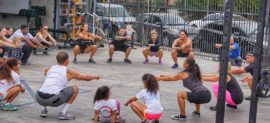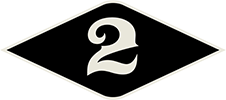
The board says, “Find a 1 RM Back Squat.” What do you do? How do you even go about that?
Having an approach would be a pretty solid idea. Having an approach that would allow you to make informed decisions as you progress to heavier weights while remaining safe is of the utmost priority would be the best idea. You want to make sure that you get enough reps to prepare your body for a maximal attempt, while also not doing too many and using up all your bullets before you ever get to your maximal attempt.
We only have the capacity for a few maximal attempts on any given day, so when you get up there having an idea of where to go is of utmost importance. If you are a person that is familiar with your one rep max, the chart below is a consistent tool to use that will allow you to approach another heavy attempt with confidence.
Empty Barbell – 8-10 Reps
-Rest 1 min-
35% – 5 Reps
-Rest 1 min-
50% – 5 Reps
-Rest 1-2 min-
65% – 5 Reps
-Rest 2-3 min-
80% – 3 Reps
-Rest 3-4 min-
90-95% – 1 Rep
-Rest 4-5 min-
Max Effort
In this chart the jumps are 15% of your current one rep for each set. This consistency allows you to evaluate your choices in weights. It is super important to remember that all you are doing in each of these sets leading up the the heavy attempt is priming your body for a later effort. Failure has no place in these ascending efforts. If you are stalling out in these reps, rack the barbell and adjust your strategy for your next jump. As the weight gets heavier you should be able to consistently move through the full range of motion. If not, you have made a jump that is too big or have attempted too many reps. This can also be a meter on how you are feeling on any given day. If you find that you can’t complete the sets with the said percentage, maybe today is not the day to go for a PR.
If you are not familiar with your current max, we can still use the same strategy for climbing up in weights. We will just go by feel.
1. Do a set of ten reps with the empty barbell.
2. Add a set of weights to the barbell and perform a set of five reps. This first set is going to have to be a bit of a guess. If its your first time with a barbell grab some smaller weights (5-25), if you are familiar feel free to go a bit heavier (25-45). Remember, this is a warm up set. When you rack the barbell evaluate how it felt. Were the five reps easy? Did they feel heavy? Did the bar move fast or slow through the range of motion?
3. Using the feedback from the last set, you will add some more weight and do another set of five. Record these jumps in weight. You will continue to do sets of five until you reach a set that the last couple reps are a definitely work. You will know this because the speed of the rep will slow. During these sets of five rest two to three minutes between sets.
4. At this point you have some numbers to look at. Ideally your jumps in weight have been somewhat similar. Example.
1. 5 reps @ 85 (~35%)
2. 5 reps @125 (~50%) – +40lbs
3. 5 reps @ 160 (~65%) – +35lbs
5. The next set will be a set of three. Ideally this set is difficult but there is no stalling out in the reps. If you are unsure of a rep rack the bar and evaluate your jump in weight. Remember right now we are just priming our body to go heavier. In this set, the jump in weight should be no more than the jumps previously made in the sets of five. In the example, we are looking at less than 35-40lbs for this next set. You will then evaluate how this felt when you finish.
-3 reps @ 185-200 (~80%) – Followed by 3-4 minutes rest.
6. Now it is time to pick a weight for your first single. In a ideal world we are looking to take two singles to find your heavy effort for the day. Depending on how the lifts work out sometimes it takes three. The first should be a weight you feel like you could definitely make, its heavy and it might feel slow, but you can make it. Using the previous jumps in weight of 35-40lbs, make a choice that is no greater than 40 lbs. Understandably your capacity to keep increasing load is slowing. So the jumps need to follow suit here. A smaller jump is a bit more realistic. (Say a 30 lb jump).
-1 rep @ 230 (~92%)
7. Evaluate how the rep felt. Was it hard? Did you lose position? Was it slow? Were you able to cruise through the rep? Its important to take stock of how this rep felt vs the set of three as far as effort/difficulty goes. What you are trying to decipher is how your body was able to handle the jump in weight. As referenced before, all of these jumps are meant to follow the information from the last set. If you notice we only have ~8% left to get to 100%(or your hypothetical PR). Your last jump was ~12%. We have room to play with the numbers depending on how you are feeling. There should be ~5 min rest before you attempt your next single.
8. Use the information from the last single to go for a max effort. Keep in mind the numbers and the descending jumps. No more than about 15-20lbs here.
-1 rep @ 250 (~100%)
Not every day is a PR day, but having a strategy as to how you approach a heavy effort will let you know right away if you are on par for a day to go heavy or a training day. Side note on the heavy singles: This ball game eventually comes down to a game of total pounds lifted in a session. Say 250lbs is your true potential on this day. If you take the two singles from above and you add the weights 230+250 you get 480. This 480lbs rests on the shoulders of all the other lead up sets. Say that you tried to get to 250 in three singles (230+240+250=720). Without question 720 is more weight than 480. I feel that you will have more luck with the 480. Set aside the exact numbers, but don’t set aside the concept. Strength gains are incremental, they are consistent over time, but they are incremental. If you set your strategy up around this, I believe you will find yourself having some success. Happy lifting and “Ring that bell” when you PR!
Danny Lesslie
@dannylesslie
8/26/16 WOD
Complete 5 rounds for reps of:
In :90…
15 Cal Row
Max Box Jumps (24/20)
-Rest 3 min-

